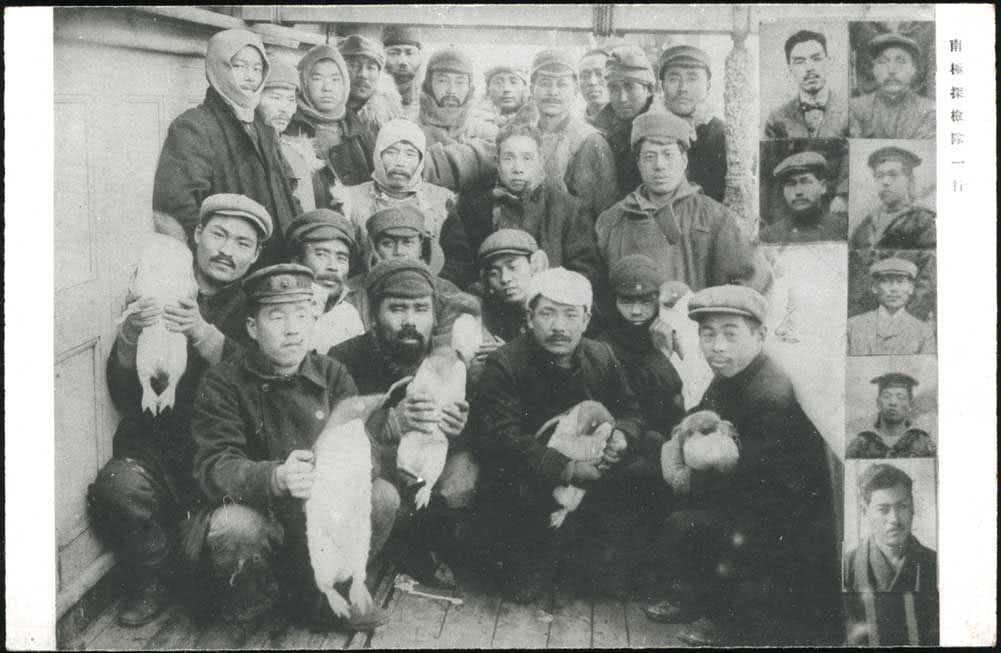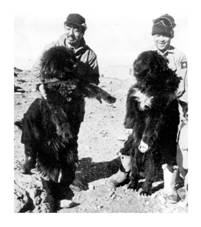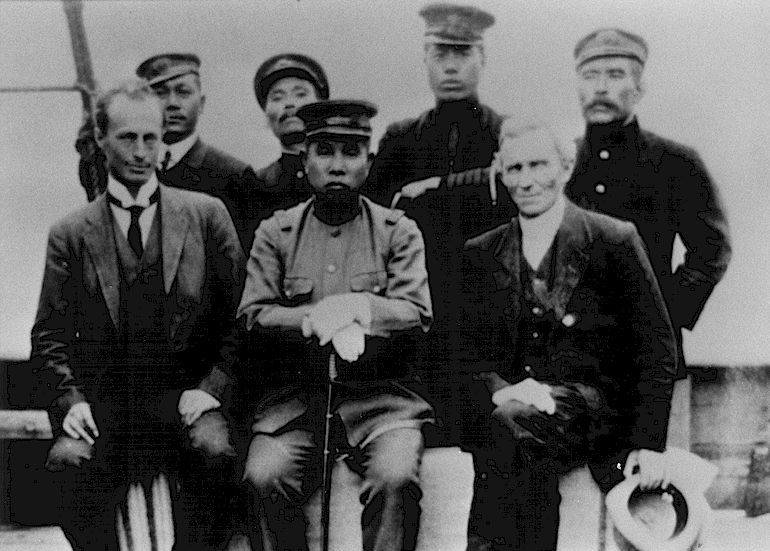Japanese Antarctic Expedition
The Japanese Antarctic expedition can be found in the international literature, usually under the heading "Japanese Antarctic Research Expedition ( JARE ) ". It is a collective term for the extensive investigations that Japan has carried out after the Second World War in Antarctica. After first expeditions in the years 1910 to 1912 as a continuation of whaling and deep sea fishing in the so-called Golden Age of Antarctic exploration Japan rose from 1956 with the firm Showa Station in the Antarctic Research a.
National Institute of Polar Research ( NIPR )
The coordination was the NIPR and was financed through the budget of the Ministry of Education, Culture, Sports, Science and Technology ( MEXT ). The annual budget in 1995 was 2.9 million yen.
NIPR provides the entire infrastructure available with the exception of the transport of material and personnel, the icebreaker Shirase for JARE - after the Antarctic explorer Nobu Shirase - takes over, which in turn is maintained by the Japanese Ministry of Defense. The scientific program on Shōwa station covers studies from the upper atmosphere, meteorology, seismology, gravimetry, geodesy and cartography, oceanography, glaciology, geology, geography, marine and terrestrial biology and medical sciences. On board the ship Shirase also the following areas can be examined: ionosphere, meteorology, geomagnetism, gravimetry and the physical, chemical and biological oceanography.
History
First Japanese expeditionary
The first Japanese Antarctic expedition found 1910-1912 under the leadership of the Army Lieutenant Nobu Shirase instead of the ship Kainan Maru. After departure in Tokyo on December 1, 1910, the expedition reached the Antarctic ice on 26 February 1911. A landing on the Antarctic continent was not until the following year on January 16, 1912, the Japanese Roald Amundsen's ship Fram encountered. They sailed further and pushed about 160 miles south of their ship landing place before until the Yamato snowfield, where they turned due to adverse weather conditions and dwindling forces. The race for the attainment of the South Pole could no longer win the Japanese. On 20 June 1912, the ship and the crew returned after a journey of more than 30,000 miles back to Yokohama back. All members of the expedition returned.
Research stations
In preparation for the International Geophysical Year (1957/1958), the Japanese government decided in 1955 to establish a national Antarctic research station.
The first station was built at the end of 1956 and based in the summer of 1957. It is located on the east Ongul Island (East Ongul Iceland ), which is about 1600 meters long and located east of the northern part of the Ongul Island is on the east side of the entrance to the Lützow -Holm Bay. Originally, this island was considered part of the Ongul Island. Only by the Japanese Antarctic Expedition ( JARE ) 1957 Fairway between two outings was discovered. The Shōwa station consisted of three buildings with a total of 184 m² of floor space. In July 1970, the Mizuho station and in January 1985 the Asuka station was added. Moreover, since 1995, working the Dome Fuji Station, where deep wells are made in the first place. All three stations had 48 m² building in 2001 with a total of nearly 6,000 land.
Since 1973 JARE considered as intra- university institution. Since 2008, the third polar icebreaker Shirase 5003 is for the stations in Antarctica go. Predecessors were in 1983 put into service 11,600 -ton icebreaker Shirase 5002 and previously Soya and Fuji. The acquisition and equipment of Shirase 5002 cost 24 billion yen. The annual budget for the research stations was the mid-1980s between three and four billion yen. The 3,800 ton ship much smaller predecessor of Soya Hokkaido since 1979 a museum ship in Tokyo, which asked 1965 in service and 5,250 -ton Fuji is a museum ship in Nagoya.
Since 1990, the International Arctic Science Committee (IASC ) works, composed of eight countries. As a member of IASC provides Japan a subset of polar research dar. focus of the work is the study of environmental influences in the atmosphere, the ocean and in animals.
Showa Station
Showa Station (昭和 基地, Shōwa kichi ), named after the Ärabezeichnung Shōwa is the parent station of the entire project. It was purchased in January 1957, has been continuously increased after an interruption from February 1962 to 1965. The interruption was caused by a high unreliability of transportation both the icebreaker and the helicopter for the transfer of traffic between ship and station. On vehement insistence of the Japanese researchers Parliament in December 1963 decided to build a new icebreaker, of overland vehicles and a new budget. The station is busy summer and winter. Here all research results also run the other stations together.
Mizuho Station
Mizuho Station (みずほ 基地, Mizuho- kichi, 70 ° 41 ' S, 44 ° 19' O 70.68333333333344.316666666667 ) was established in January 1970. The station is located about 270 km to the southeast of Showa Station at 2,230 meters above the sea on the Mizuho Plateau. Mizuho station is not manned at all, only in the ten years from 1976 to 1986 there were constantly people who meteorology, glaciology and the Upper Atmosphere observed, as it now only occasionally happens.
Asuka Station
Asuka station (あすか 基地, Asuka- kichi, 71 ° 31 ' 34 "S, 24 ° 8' 17 " O 71.52611111111124.138055555556 ), named after Asuka- kyō, is on 930.5 meters above sea level north of the Sor Rondane mountains and was built on March 26, 1985. It has a total area of 450 square meters and is now mostly under snow and ice. The station serves as a starting point for the field research in the field of geology, geomorphology, meteorite, glaciology and biology in the Sor Rondane mountains. The Sor Rondane Mountains are an approximately 160 km long mountain range, which rises to 3,400 meters above the sea. From 1987 to 1991, the station continuously occupied for the purpose of research in the fields of meteorology, glaciology, the core - mantle boundary, which is named after their discoverers, Emil Wiechert and Beno Gutenberg also Wiechert- Gutenberg discontinuity, and the upper atmosphere.
On an annual average between 1985 and 1990 the temperature of -18.3 ° C and the wind speed was 12.6 m / s The maximum temperature of -0.5 ° C was measured on 5 January 1990 and the lowest temperature of -48.7 ° C on August 9, 1987.
Dome Fuji Station
The Dome Fuji Station (ドーム ふじ 基地, Domu Fuji kichi, 77 ° 19 '1 " S, 39 ° 42' 12" E - 77.31694444444439.703333333333 ) is located on the summit of 3,810 meters above sea level high Dome Fuji and was taken as far last, Japanese station into operation on 29 January 1995. It is located about 1000 km south of the Showa Station.
Here deep holes are made in the ice (up to 2,500 meters) to study environmental impacts and climate change in the first place. In recent years, the environmental protection for the unique ecosystem in the Antarctic has been recognized as extremely important and considered in accordance with international agreements.
Naming
The " Takaki Promontory " (65 ° 33 ' S, 64 ° 34' W 65.55 - 64.566666666667 ) in Antarctica, a peninsula, was named after Takaki Kanehiro, a Navy doctor and a member of the Japanese mansion. He is the first and only Japanese, which was bestowed the honor of naming of land in Antarctica. Takaki had helped the Japanese Navy, the end of the 19th century to combat the dietary vitamin deficiency disease beriberi, which greatly facilitated the Antarctica trip in 1910. Especially with Japanese crews came before Takakis research after prolonged diet with white rice to a variety of deadly diseases, the Japanese army still 1905. The actual cause, a deficiency of thiamine was only in 1925 elucidated by Christiaan Eijkman, for which this 1929 received the Nobel Prize.










